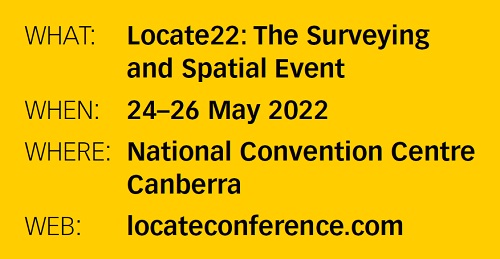
©stock.adobe.com/au/THANANIT
Here’s a preview of what you’ll see, learn and experience at the Locate22 conference in Canberra in May.
It’s not an exaggeration to say that Locate22 is one of the most eagerly awaited and highly anticipated events in recent years. The COVID disruptions of the past 24-plus months have meant that most face-to-face meetings and conferences had to be cancelled, so this will be the first time in around three years that industry members will have been able to meet their colleagues from across the region and catch up on all the latest developments and announcements.
The Master of Ceremonies will be Associate Professor Catherine Ball. Dr Ball is a scientific futurist, speaker, advisor, author, business founder and company director working across global projects where emerging technologies meet humanitarian, education and environmental needs.
The conference program features a host of expert speakers from around Australia and across the globe. Headlining the list are:
- Professor Lisa Harvey-Smith, astrophysicist, the Australian Government’s Women in STEM Ambassador and a Professor of Practice in Science Communication at UNSW
- Adrian Turner, Chief Executive Officer of the Minderoo Foundation Fire & Flood Resilience Initiative
- Melissa Harris, Chief Executive of Land Use Victoria, and Chair of the Australia And New Zealand Land Information Council (ANZLIC)
- Dr James Johnson, Chief Executive Officer of Geoscience Australia
- Thalia Baldwin, Director of the UK Geospatial Commission
- Dr David Gruen, Australian Statistician and CEO of the Australian Bureau of Statistics
- Rebecca De Cicco, Principal, Digital Operations at Aurecon, Director Digital Node and Global Chair of Women in BIM
- Dr Stefan Hrabar, CEO and co-founder of Emesent
- Dr Monica Wachowicz, Associate Dean of Geospatial at RMIT University and Cisco Innovation Chair in Big Data
- Tom Hamilton, Director of the Australian Geospatial-Intelligence Organisation
- Dr Fiona McKenzie, Director of Orange Compass
- Jack Dangermond, Founder and President of Esri
Dangermond was the final plenary speaker to be announced. Securing him to present the closing session on Thursday afternoon, 26 May, is a major coup for the organisers. He is recognised the world over as a pioneer of the spatial technologies industry. For more than 50 years, he has been a constant and dominant driving force within the global spatial community, focused on the advancement of GIS technology.
There are too many fabulous speakers to cover all of them and their keynote topics in this short article, so we’ll just pick two. Firstly, Dr David Gruen, who was appointed Australian Statistician in December 2019, and, as Agency Head of the Australian Bureau of Statistics, is accountable for the functions and operations of the Bureau.
Dr Gruen became exposed to the geospatial world when working as a Deputy in the Department of the Prime Minister and Cabinet, when a joint agency taskforce was set up in 2018 to respond to the widespread droughts that Australia was experiencing at the time. With help from Data61 and others, a national drought map was developed. “I remember thinking that that was a very powerful visual tool to help people get a sense of what was available to support communities in drought, and basically a visual way of presenting information that would have been a lot less compelling had it been presented in a table or a series of documents,” Dr Gruen said.
“I’ve now been at the Australian Bureau of Statistics for two years, and in that time there’s been quite a lift in our interest and involvement in geospatial information. It would be fair to say that my interest in all things geospatial has been growing.
“The ABS is getting increasingly interested in geospatial data,” he added. “Certainly, the geospatial aspect of the Census is always important to the extent that we can provide information at small area [scales]. The same is true of our environmental team, where the geospatial element of the environment is critical.”
Referring to the rise of the kind big data that includes geospatial information, Dr Gruen said that “Not only does that generate powerful insights, but it also generates issues regarding privacy and making sure that you treat the data in a way that does not reveal information about individuals or, for that matter, individual companies.”
Dr Gruen will be speaking on Wednesday, 25 May, on the topic of building geospatial data capabilities across the Australian Public Service.

Another speaker will be Dr Fiona McKenzie, who will give a keynote presentation in the session ‘Technology and Transformation,’ speaking about ‘From disruption to transformation: shaping the future in a rapidly changing world’. A name sometimes given to these disruptions is ‘megatrends’.
“Megatrends ignore boundaries — they ignore spatial boundaries [and] boundaries of expertise of industries,” Dr McKenzie said. “These trends sit within what I would call complex adaptive systems — systems where no single person can see or understand the whole. And so we need to collaborate, we need to find common ground and talk to other industries to really understand what’s going on.”
“Some of the big headline trends — like geopolitics, demographics, resource scarcity, climate change — in some ways they’re all reaching a crescendo. None of them are getting less important.”
In relation to geospatial, Dr McKenzie said that “I think when it comes to the geospatial industry and all the data and the shifts that we’re seeing, we’re essentially running a global experiment at the moment. When you think about, say, how recently online mapping came to life — Google Maps only launched in 2005. If you think about what it does to a society when something like Google Maps or Google data can provide real-time mobility data that tells us the effects of a COVID lockdown – what does that do? Or using in-built GPS in our cars and now the evidence showing it is shrinking a part of our brain responsible for navigation?”
Dr McKenzie’s presentation will take place on Wednesday, 25 May.
As well as speaker sessions, the four-day event will encompass a wide range of other hands-on activities and interactive and networking opportunities:
- Exhibition with vendor displays and demonstrations
- Workshops and tech talks
- The Locate Hub
- Social networking and Georabble
- Young professional, student and early career researcher workshop
- The Locate Symposium
- Tours, both guided and self-guided
- Asia-Pacific Spatial Excellence Awards
For full details about the speakers, workshops and other activities, along with registration details, visit https://locateconference.com.
This article was first published in the Apr/May 2022 issue of Position magazine.
Stay up to date by getting stories like this delivered to your inbox.
Sign up to receive our free weekly Spatial Source newsletter.












